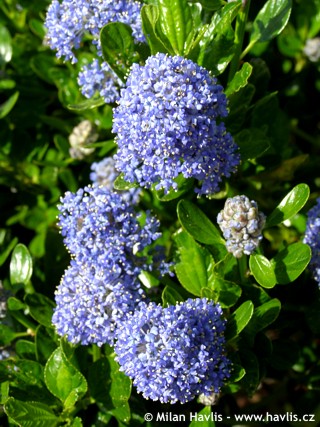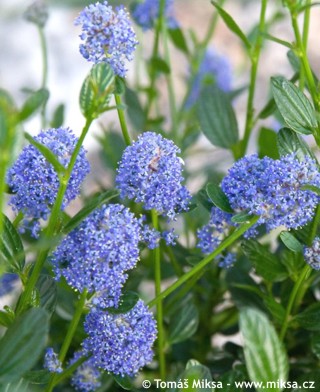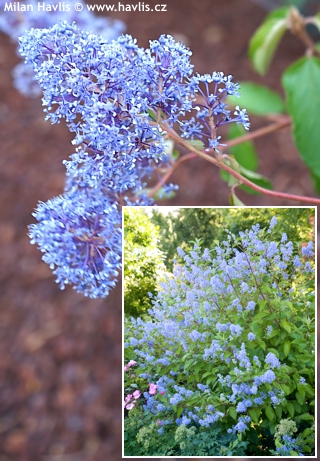Ceanothus thyrsiflorus 'SKYLARK' blueblossom, California lilac
size/type
medium-sized shrub,medium-sized shrub
usual height
0,5-1,5m
usual width
1,5-2m
leaves
evergreen broadleaf
colour of leaves
flowers
showy
colour of flowers
blooming time
June-June
location
full sun
soil type
acidic (peaty) to neutral
soil moisture requirements
evenly moist (dislikes drought)
USDA zone (lowest)
6b (down to -21°C)
winter protection
for zone 5+6

for zone 7

categorized
Ceanothus
Blueblossom originates in California and Mexico and these days it is getting more and more popular in our climate though it is supposed to be a tender plant. However, there are varieties which, with a certain degree of winter protection, can cope well and offer its lovely shade of blue flowers.Description of the plant:
Skylark is a variety very similar to Victoria, with two exceptions: it has slightly larger leaves and arching branches.The flowers are absolutely amazing, not violet, not pale, just unbeatable sky blue. They are formed in rounded, 6-7 cm long, terminal cymes and come out in early June and usually last for about a month. That is another reason to own this gorgeousness. There are so many of them every year that they totally cover the plant. Evergreen leaves are only 2-3 cm long, ovate, dark green, very glossy and deeply veined. When crushed they have an interesting spicy scent.
It grows medium fast or fast, making arching, almost horizontal branches. It gets wider than tall, seldom exceeding 1.5m high. If you wish to keep it compact and smaller, prune it every year after it has flowered (early July). The denser it gets the hardier it will be over winter. Unpruned plants may get leggy over a few years.
It needs fertile, permeable soil, adequately moist for the first year and preferably slightly acidic as it might suffer from chlorosis (leaves turn yellow and the plant defoliates when it cannot absorb ferrum from the soil). Do not apply fertilizers for faster growth. Too long shoots will not have enough time to mature and will be killed in winter. You can use a slow release selective fertilizer for profuse flowering or leaf colour. What you definitely must do is to provide a thick layer of mulch, especially before winter. Plant it in a location sheltered from winds - best against a wall or in a closed yard. For reliable overwintering you also need to find a place that will be insolated in summer but shaded in winter - long-lasting winter sun in combination with frost may cause visible injuries.
Growing it in our garden (USDA zone 6) it proved to be fully hardy to some -16° or even -18°C on a sheltered spot, and it survived -24°C with a protection made of 2-3 layers of white woven. Overwrap the plant with this protective fabric when the temperature drops below -16°C for maximum 2 weeks, and take it off when the weather improves. It must not be wrapped all winter, otherwise it will be damaged by strong spring sun. This stunning beauty is worth a portion of extra work. Reliably hardy to -17°C (USDA zone 7) with protection much lower (USDA zone 6).
Last update 20-12-2008
QUICK PRICE OVERVIEW
CURRENTLY SOLD OUT
WANT TO TRY A SIMILAR PLANT?


















